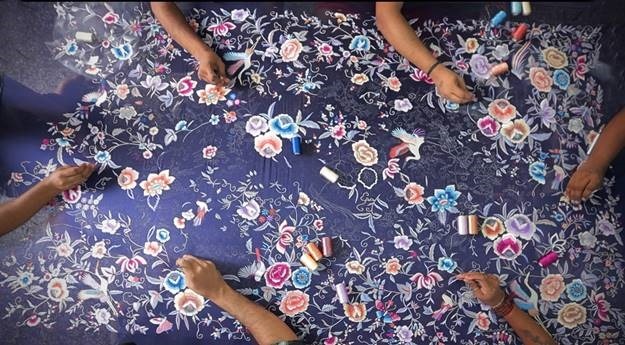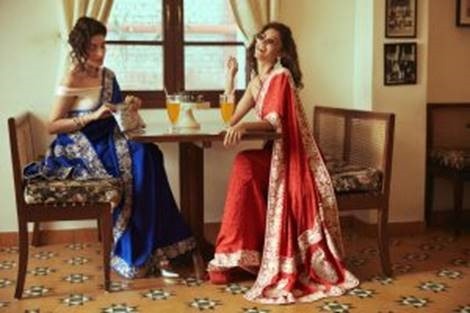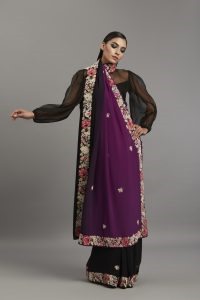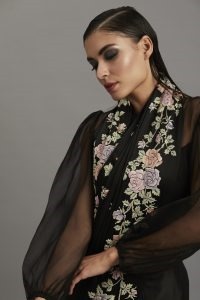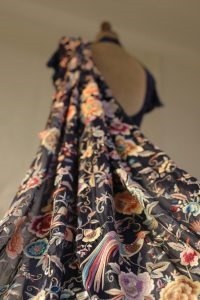They hide within their folds the story of voyages at sea, the old trading routes and the rise and blossoming of an entire community
Article By Shaeroy Chinoy | Elle
Traditional Indian textiles and art forms speak volumes about history, the regions they come from, the culture and art, but often there is a deeper story. The Parsi Gara is one such great example. They hide within their folds the story of voyages at sea, the old trading routes and the rise and blossoming of an entire community.
In the 19th century, when Parsi traders took to the high seas to trade with China, they discovered a beautiful silk fabric called gaaj or paaj. So exquisite was its beauty that they ended up buying yards to take home. These saris soon became a symbol of status. Combining the beauty inherent in four cultural traditions – Persian, Chinese, Indian and European – this exquisite textile form remains an intercultural craft.
The embroidery on a Gara sari, as it came to be known, is exquisite. The motifs are influenced by the flora, birds, fruits, and even scenes and stories of Chinese origin like the bridges, pagodas, boatmen and shrines. It’s like an entire story woven onto a piece of clothing. There are various techniques like the Satin stitch, crewel stitch, stem stitch and French knots used to create these intricate masterpieces by hand. Garas were traditionally seen in royal colours like purple, dark green, wine, orange-red, maroon, black and magenta. For a Parsi woman, it is mandatory to wear a Gara for any one of the pre-wedding functions. To date, it is worn in the traditional style wherein the head is covered. The saris are considered heirlooms in the family and are fiercely protected by the womenfolk – just like an expensive piece of jewellery.
We caught up with designer Ashdeen Lilaowala, who retails the Gara sari, to know more about trends, things to remember while investing in the sari and more. Excerpts.
ELLE: What gives the Gara an heirloom status in a Parsi family?
Ashdeen Lilaowala (AL): It isn’t easy to pinpoint specific factors that may lead to a Gara acquiring heirloom status in a Parsi family. It is a complex combination of emotional factors such as who the Gara originally belonged to, the occasion it was bought for, and the richness of the embroidery, the colour and aesthetics and the overall condition of the piece. That being said, we Parsis have a reputation for being collectors and a tradition of carefully preserving our textiles and artefacts.
ELLE: What, according to you, is the significance of the Gara today? How do you keep the traditional art form relevant?
AL: Ours is a small community, and this niche craft is being practised by a handful of people. As much as people love the craft, there is always a risk that in the future, it might become obscure and lesser-known unless we actively document and conserve it. At the beginning of my career, I worked closely with UNESCO’s Parzor Foundation to do exactly that. But a lot more efforts in this direction are needed to keep the tradition alive. We are closely in touch with the younger generation to understand their needs and constantly think about how we can strike the perfect balance between keeping the essence of the Gara alive while innovating in applications.
ELLE: What are some of the most in-demand Gara designs?
AL: Contemporary interpretations and stylised versions of typical Parsi Gara motifs such as China-Chini and kors find applications on our Gara-Inspired saris, alongside flora and fauna motifs representing the Zoroastrian reverence for nature.
ELLE: What are some of the things one should consider while investing in an authentic Gara?
AL: Gara embroidery is an aesthetic that has evolved over the years. An authentic Gara is hundred per cent hand-embroidered—don’t let anyone tell you otherwise. Besides that, I would say always invest in a brand that comes from the heart of the Parsi community. There are so many imitations around.
ELLE: Can the motifs of older Garas be transferred onto a new sari?
AL: It is part of the Parsi Gara tradition to transfer richly embroidered borders traditionally known as kors, from old damaged Garas to newer ones. In our studio, we have been repairing and transferring old Garas for our clients. It is an intrinsically green and eco-friendly textile culture.
ELLE: How do you train your artisans in this unique art form, and how do you equip them to shape your vision?
AL: Our artisans are at the centre of our enterprise, and I am so grateful for them. Most of them hail from West Bengal and are traditionally trained to work with the aari needle. Over the years, we have slowly trained them in the Parsi aesthetic and specialised techniques like the French knot or khakha, which you will find extensively in Parsi Garas and our other saris.
Photos: Ashdeen Lilaowala

